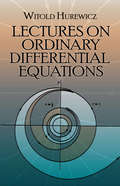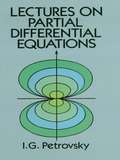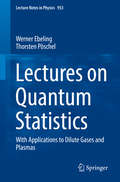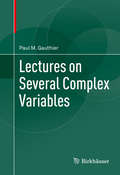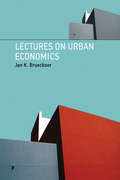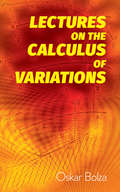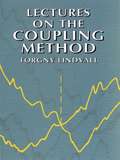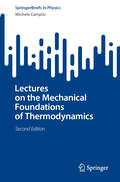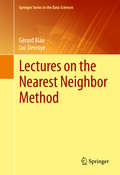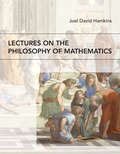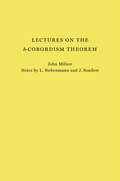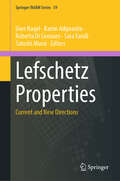- Table View
- List View
Lectures on Optimal Transport (UNITEXT #169)
by Luigi Ambrosio Elia Brué Daniele SemolaThis textbook is addressed to PhD or senior undergraduate students in mathematics, with interests in analysis, calculus of variations, probability and optimal transport. It originated from the teaching experience of the first author in the Scuola Normale Superiore, where a course on optimal transport and its applications has been given many times during the last 20 years. The topics and the tools were chosen at a sufficiently general and advanced level so that the student or scholar interested in a more specific theme would gain from the book the necessary background to explore it. After a large and detailed introduction to classical theory, more specific attention is devoted to applications to geometric and functional inequalities and to partial differential equations. This is the second edition of the book, first published in 2018. It includes refinement of proofs, an updated bibliography and a more detailed discussion of minmax principles, with the aim of giving two fully self-contained proofs of Kantorovich duality.
Lectures on Ordinary Differential Equations (Dover Books on Mathematics)
by Witold HurewiczHailed by The American Mathematical Monthly as "a rigorous and lively introduction," this text explores a topic of perennial interest in mathematics. The author, a distinguished mathematician and formulator of the Hurewicz theorem, presents a clear and lucid treatment that emphasizes geometric methods. Topics include first-order scalar and vector equations, basic properties of linear vector equations, and two-dimensional nonlinear autonomous systems. Suitable for senior mathematics students, the text begins with an examination of differential equations of the first order in one unknown function. Subsequent chapters address systems of differential equations, linear systems of differential equations, singularities of an autonomous system, and solutions of an autonomous system in the large.
Lectures on Partial Differential Equations
by I. G. PetrovskyThe field of partial differential equations is an extremely important component of modern mathematics. It has great intrinsic beauty and virtually unlimited applications. This book, written for graduate-level students, grew out of a series of lectures the late Professor Petrovsky gave at Moscow State University. The first chapter uses physical problems to introduce the subjects and explains its division into hyperbolic, elliptic, and parabolic partial differential equations. Each of these three classes of equations is dealt with in one of the remaining three chapters of the book in a manner that is at once rigorous, transparent, and highly readable.Petrovsky was a leading figure in Russian mathematics responsible for many advances in the field of partial differential equations. In these masterly lectures, his commentary and discussion of various aspects of the problems under consideration will prove valuable in deepening students’ understanding and appreciation of these problems.
Lectures on Profinite Topics in Group Theory
by Benjamin Klopsch Nikolay Nikolov Christopher VollIn this book, three authors introduce readers to strong approximation methods, analytic pro-p groups and zeta functions of groups. Each chapter illustrates connections between infinite group theory, number theory and Lie theory. The first introduces the theory of compact p-adic Lie groups. The second explains how methods from linear algebraic groups can be utilised to study the finite images of linear groups. The final chapter provides an overview of zeta functions associated to groups and rings. Derived from an LMS/EPSRC Short Course for graduate students, this book provides a concise introduction to a very active research area and assumes less prior knowledge than existing monographs or original research articles. Accessible to beginning graduate students in group theory, it will also appeal to researchers interested in infinite group theory and its interface with Lie theory and number theory.
Lectures on Profinite Topics in Group Theory
by Benjamin Klopsch Nikolay Nikolov Christopher VollIn this book, three authors introduce readers to strong approximation methods, analytic pro-p groups and zeta functions of groups. Each chapter illustrates connections between infinite group theory, number theory and Lie theory. The first introduces the theory of compact p-adic Lie groups. The second explains how methods from linear algebraic groups can be utilised to study the finite images of linear groups. The final chapter provides an overview of zeta functions associated to groups and rings. Derived from an LMS/EPSRC Short Course for graduate students, this book provides a concise introduction to a very active research area and assumes less prior knowledge than existing monographs or original research articles. Accessible to beginning graduate students in group theory, it will also appeal to researchers interested in infinite group theory and its interface with Lie theory and number theory.
Lectures on Quantum Field Theory and Functional Integration
by Zbigniew HabaThis book offers a concise introduction to quantum field theory and functional integration for students of physics and mathematics. Its aim is to explain mathematical methods developed in the 1970s and 1980s and apply these methods to standard models of quantum field theory. In contrast to other textbooks on quantum field theory, this book treats functional integration as a rigorous mathematical tool. More emphasis is placed on the mathematical framework as opposed to applications to particle physics. It is stressed that the functional integral approach, unlike the operator framework, is suitable for numerical simulations. The book arose from the author's teaching in Wroclaw and preserves the form of his lectures. So some topics are treated as an introduction to the problem rather than a complete solution with all details. Some of the mathematical methods described in the book resulted from the author's own research.
Lectures on Quantum Statistics: With Applications to Dilute Gases and Plasmas (Lecture Notes in Physics #953)
by Werner Ebeling Thorsten PöschelMost of the matter in our universe is in a gaseous or plasma state. Yet, most textbooks on quantum statistics focus on examples from and applications in condensed matter systems, due to the prevalence of solids and liquids in our day-to-day lives. In an attempt to remedy that oversight, this book consciously focuses on teaching the subject matter in the context of (dilute) gases and plasmas, while aiming primarily at graduate students and young researchers in the field of quantum gases and plasmas for some of the more advanced topics. The majority of the material is based on a two-semester course held jointly by the authors over many years, and has benefited from extensive feedback provided by countless students and co-workers. The book also includes many historical remarks on the roots of quantum statistics: firstly because students appreciate and are strongly motivated by looking back at the history of a given field of research, and secondly because the spirit permeating this book has been deeply influenced by meetings and discussions with several pioneers of quantum statistics over the past few decades.
Lectures on Random Interfaces
by Tadahisa FunakiInterfaces are created to separate two distinct phases in a situation in which phase coexistence occurs. This book discusses randomly fluctuating interfaces in several different settings and from several points of view: discrete/continuum, microscopic/macroscopic, and static/dynamic theories. The following four topics in particular are dealt with in the book. Assuming that the interface is represented as a height function measured from a fixed-reference discretized hyperplane, the system is governed by the Hamiltonian of gradient of the height functions. This is a kind of effective interface model called ∇φ-interface model. The scaling limits are studied for Gaussian (or non-Gaussian) random fields with a pinning effect under a situation in which the rate functional of the corresponding large deviation principle has non-unique minimizers. Young diagrams determine decreasing interfaces, and their dynamics are introduced. The large-scale behavior of such dynamics is studied from the points of view of the hydrodynamic limit and non-equilibrium fluctuation theory. Vershik curves are derived in that limit. A sharp interface limit for the Allen-Cahn equation, that is, a reaction-diffusion equation with bistable reaction term, leads to a mean curvature flow for the interfaces. Its stochastic perturbation, sometimes called a time-dependent Ginzburg-Landau model, stochastic quantization, or dynamic P(φ)-model, is considered. Brief introductions to Brownian motions, martingales, and stochastic integrals are given in an infinite dimensional setting. The regularity property of solutions of stochastic PDEs (SPDEs) of a parabolic type with additive noises is also discussed. The Kardar-Parisi-Zhang (KPZ) equation , which describes a growing interface with fluctuation, recently has attracted much attention. This is an ill-posed SPDE and requires a renormalization. Especially its invariant measures are studied.
Lectures on Real-valued Functions
by Alexander KharazishviliThis book offers several topics of mathematical analysis which are closely connected with significant properties of real-valued functions of various types (such as semi-continuous functions, monotone functions, convex functions, measurable functions, additive and linear functionals, etc.). Alongside with fairly traditional themes of real analysis and classical measure theory, more profound questions are thoroughly discussed in the book – appropriate extensions and restrictions of functions, oscillation functions and their characterization, discontinuous functions on resolvable topological spaces, pointwise limits of finite sums of periodic functions, some general results on invariant and quasi-invariant measures, the structure of non-measurable sets and functions, the Baire property of functions on topological spaces and its connections with measurability properties of functions, logical and set-theoretical aspects of the behavior of real-valued functions.
Lectures on Several Complex Variables
by Paul M. GauthierThis monograph provides a concise, accessible snapshot of key topics in several complex variables, including the Cauchy Integral Formula, sequences of holomorphic functions, plurisubharmonic functions, the Dirichlet problem, and meromorphic functions. Based on a course given at Université de Montréal, this brief introduction covers areas of contemporary importance that are not mentioned in most treatments of the subject, such as modular forms, which are essential for Wiles' theorem and the unification of quantum theory and general relativity. Also covered is the Riemann manifold of a function, which generalizes the Riemann surface of a function of a single complex variable and is a topic that is well-known in one complex variable, but rarely treated in several variables. Many details, which are intentionally left out, as well as many theorems are stated as problems, providing students with carefully structured instructive exercises. Prerequisites for use of this book are functions of one complex variable, functions of several real variables, and topology, all at the undergraduate level. Lectures on Several Complex Variables will be of interest to advanced undergraduate and beginning undergraduate students, as well as mathematical researchers and professors.
Lectures on Sphere Arrangements – the Discrete Geometric Side
by Károly BezdekThis monograph gives a short introduction to the relevant modern parts of discrete geometry, in addition to leading the reader to the frontiers of geometric research on sphere arrangements. The readership is aimed at advanced undergraduate and early graduate students, as well as interested researchers. It contains more than 40 open research problems ideal for graduate students and researchers in mathematics and computer science. Additionally, this book may be considered ideal for a one-semester advanced undergraduate or graduate level course. The core part of this book is based on three lectures given by the author at the Fields Institute during the thematic program on "Discrete Geometry and Applications" and contains four core topics. The first two topics surround active areas that have been outstanding from the birth of discrete geometry, namely dense sphere packings and tilings. Sphere packings and tilings have a very strong connection to number theory, coding, groups, and mathematical programming. Extending the tradition of studying packings of spheres, is the investigation of the monotonicity of volume under contractions of arbitrary arrangements of spheres. The third major topic of this book can be found under the sections on ball-polyhedra that study the possibility of extending the theory of convex polytopes to the family of intersections of congruent balls. This section of the text is connected in many ways to the above-mentioned major topics and it is also connected to some other important research areas as the one on coverings by planks (with close ties to geometric analysis). This fourth core topic is discussed under covering balls by cylinders.
Lectures on Urban Economics
by Brueckner Jan K.Lectures on Urban Economics offers a rigorous but nontechnical treatment of major topics in urban economics. To make the book accessible to a broad range of readers, the analysis is diagrammatic rather than mathematical. Although nontechnical, the book relies on rigorous economic reasoning. In contrast to the cursory theoretical development often found in other textbooks, Lectures on Urban Economics offers thorough and exhaustive treatments of models relevant to each topic, with the goal of revealing the logic of economic reasoning while also teaching urban economics. Topics covered include reasons for the existence of cities, urban spatial structure, urban sprawl and land-use controls, freeway congestion, housing demand and tenure choice, housing policies, local public goods and services, pollution, crime, and quality of life. Footnotes throughout the book point to relevant exercises, which appear at the back of the book. These 22 extended exercises (containing 125 individual parts) develop numerical examples based on the models analyzed in the chapters. Lectures on Urban Economics is suitable for undergraduate use, as background reading for graduate students, or as a professional reference for economists and scholars interested in the urban economics perspective.
Lectures on Urban Economics
by Jan K. BruecknerA rigorous but nontechnical treatment of major topics in urban economics. Lectures on Urban Economics offers a rigorous but nontechnical treatment of major topics in urban economics. To make the book accessible to a broad range of readers, the analysis is diagrammatic rather than mathematical. Although nontechnical, the book relies on rigorous economic reasoning. In contrast to the cursory theoretical development often found in other textbooks, Lectures on Urban Economics offers thorough and exhaustive treatments of models relevant to each topic, with the goal of revealing the logic of economic reasoning while also teaching urban economics. Topics covered include reasons for the existence of cities, urban spatial structure, urban sprawl and land-use controls, freeway congestion, housing demand and tenure choice, housing policies, local public goods and services, pollution, crime, and quality of life. Footnotes throughout the book point to relevant exercises, which appear at the back of the book. These 22 extended exercises (containing 125 individual parts) develop numerical examples based on the models analyzed in the chapters. Lectures on Urban Economics is suitable for undergraduate use, as background reading for graduate students, or as a professional reference for economists and scholars interested in the urban economics perspective.
Lectures on Visco-Plastic Fluid Mechanics (CISM International Centre for Mechanical Sciences #583)
by Guillaume Ovarlez Sarah HormoziThe book is designed for advanced graduate students as well as postdoctoral researchers across several disciplines (e.g., mathematics, physics and engineering), as it provides them with tools and techniques that are essential in performing research on the flow problems of visco-plastic fluids. The following topics are treated: analysis of classical visco-plastic fluid modelsmathematical modeling of flows of visco-plastic fluidscomputing flows of visco-plastic fluidsrheology of visco-plastic fluids and visco-plastic suspensionsapplication of visco-plastic fluids in engineering sciencescomplex flows of visco-plastic fluids.
Lectures on the Calculus of Variations (Dover Books on Mathematics)
by Oskar BolzaThis pioneering modern treatise on the calculus of variations studies the evolution of the subject from Euler to Hilbert. The text addresses basic problems with sufficient generality and rigor to offer a sound introduction for serious study. It provides clear definitions of the fundamental concepts, sharp formulations of the problems, and rigorous demonstrations of their solutions. Many examples are solved completely, and systematic references are given for each theorem upon its first appearance. Initial chapters address the first and second variation of the integral, and succeeding chapters cover the sufficient conditions for an extremum of the integral and Weierstrass's theory of the problem in parameter-representation; Kneser's extension of Weierstrass's theory to cover the case of variable end-points; and Weierstrass's theory of the isoperimetric problems. The final chapter presents a thorough proof of Hilbert's existence theorem.
Lectures on the Coupling Method
by Torgny LindvallAn important tool in probability theory and its applications, the coupling method is primarily used in estimates of total variation distances. The method also works well in establishing inequalities, and it has proven highly successful in the study of Markov and renewal process asymptotics. This text represents a detailed, comprehensive examination of the method and its broad variety of applications. Readers progress from simple to advanced topics, with end-of-discussion notes that reinforce the preceding material. Topics include renewal theory, Markov chains, Poisson approximation, ergodicity, and Strassen's theorem. A practical and easy-to-use reference, this volume will accommodate the diverse needs of professionals in the fields of statistics, mathematics, and operational research, as well as those of teachers and students.
Lectures on the Mechanical Foundations of Thermodynamics (SpringerBriefs in Physics)
by Michele CampisiThis brief provides a modern pedagogical exposition of the mechanical approach to statistical mechanics initiated by Boltzmann with his early works (1866-1871). Despite the later contribution by Helmholtz, Boltzmann himself (1884-1887), Gibbs, P. Hertz, and Einstein, the mechanical approach remained almost unknown to the modern reader, in favour of the celebrated combinatorial approach, developed by Boltzmann himself during his probabilistic turn (1876-1884). The brief constitutes an ideal continuation of a graduate course of classical mechanics and requires knowledge of basic calculus in many dimension (including differential forms), thermodynamics, probability theory, besides Hamiltonian mechanics. The cornerstone of the whole presentation is the ergodic hypothesis. Special attention is devoted to Massieu potentials (the Legendre transforms of the entropy) which are most natural in statistical mechanics, and also allow for a more direct treatment of the topic of ensemble equivalence.
Lectures on the Mechanical Foundations of Thermodynamics (SpringerBriefs in Physics)
by Michele CampisiThis book provides a modern pedagogical exposition of the mechanical approach to statistical mechanics initiated by Boltzmann with his early works (1866–1871). Despite the later contribution by Helmholtz, Boltzmann himself (1884–1887), Gibbs, P. Hertz, and Einstein, the mechanical approach remained almost unknown to the modern reader, in favour of the celebrated combinatorial approach, developed by Boltzmann himself during his probabilistic turn (1876–1884). The brief constitutes an ideal continuation of a graduate course of classical mechanics and requires knowledge of basic calculus in many dimensions (including differential forms), thermodynamics, and probability theory, besides Hamiltonian mechanics. The cornerstone of the whole presentation is the ergodic hypothesis. Special attention is devoted to Massieu potentials (the Legendre transforms of the entropy) which are most natural in statistical mechanics and also allow for a more direct treatment of the topic of ensemble equivalence. In this second edition, a chapter is added that addresses the long-debated question of how the second law of thermodynamics can be reconciled with mechanics, by using modern methods of non-equilibrium statistical mechanics.
Lectures on the Nearest Neighbor Method
by Gérard Biau Luc DevroyeThis text presents a wide-ranging and rigorous overview of nearest neighbor methods, one of the most important paradigms in machine learning. Now in one self-contained volume, this book systematically covers key statistical, probabilistic, combinatorial and geometric ideas for understanding, analyzing and developing nearest neighbor methods. Gérard Biau is a professor at Université Pierre et Marie Curie (Paris). Luc Devroye is a professor at the School of Computer Science at McGill University (Montreal).
Lectures on the Philosophy of Mathematics
by Joel David HamkinsAn introduction to the philosophy of mathematics grounded in mathematics and motivated by mathematical inquiry and practice.In this book, Joel David Hamkins offers an introduction to the philosophy of mathematics that is grounded in mathematics and motivated by mathematical inquiry and practice. He treats philosophical issues as they arise organically in mathematics, discussing such topics as platonism, realism, logicism, structuralism, formalism, infinity, and intuitionism in mathematical contexts. He organizes the book by mathematical themes--numbers, rigor, geometry, proof, computability, incompleteness, and set theory--that give rise again and again to philosophical considerations.
Lectures on the Poisson Process (Institute of Mathematical Statistics Textbooks #7)
by Mathew Penrose Günter LastThe Poisson process, a core object in modern probability, enjoys a richer theory than is sometimes appreciated. This volume develops the theory in the setting of a general abstract measure space, establishing basic results and properties as well as certain advanced topics in the stochastic analysis of the Poisson process. Also discussed are applications and related topics in stochastic geometry, including stationary point processes, the Boolean model, the Gilbert graph, stable allocations, and hyperplane processes. Comprehensive, rigorous, and self-contained, this text is ideal for graduate courses or for self-study, with a substantial number of exercises for each chapter. Mathematical prerequisites, mainly a sound knowledge of measure-theoretic probability, are kept in the background, but are reviewed comprehensively in the appendix. The authors are well-known researchers in probability theory; especially stochastic geometry. Their approach is informed both by their research and by their extensive experience in teaching at undergraduate and graduate levels.
Lectures on the Random Field Ising Model: From Parisi-Sourlas Supersymmetry to Dimensional Reduction (SpringerBriefs in Physics)
by Slava RychkovThis book is about the Random Field Ising Model (RFIM) – a paradigmatic spin model featuring a frozen disordering field. The focus is on the second-order phase transition between the paramagnetic and ferromagnetic phases, and the associated critical exponents. The book starts by summarizing the current knowledge about the RFIM from experiments, numerical simulations and rigorous mathematical results. It then reviews the classic theoretical works from the 1970’s which suggested a property of dimensional reduction – that the RFIM critical exponents should be the same as for the ordinary, non-disordered, Ising model of lower dimensionality, and related this an emergent Parisi-Sourlas supersymmetry. As is now known, these remarkable properties only hold when the spatial dimensionality of the model is larger than a critical dimension. The book presents a method to estimate the critical dimension, using standard tools such as the replica trick and perturbative renormalization group, whose result is in agreement with the numerical simulations. Some more elementary steps in the derivations are left as exercises for the readers. This book is of interest to researchers, PhD students and advanced master students specializing in statistical field theory.
Lectures on the h-Cobordism Theorem
by John MilnorImportant lectures on differential topology by acclaimed mathematician John MilnorThese are notes from lectures that John Milnor delivered as a seminar on differential topology in 1963 at Princeton University. These lectures give a new proof of the h-cobordism theorem that is different from the original proof presented by Stephen Smale. Milnor's goal was to provide a fully rigorous proof in terms of Morse functions. This book remains an important resource in the application of Morse theory.
Lee de Forest
by Mike AdamsThe life-long inventor, Lee de Forest invented the three-element vacuum tube used between 1906 and 1916 as a detector, amplifier, and oscillator of radio waves. Beginning in 1918 he began to develop a light valve, a device for writing and reading sound using light patterns. While he received many patents for his process, he was initially ignored by the film industry. In order to promote and demonstrate his process he made several hundred sound short films, he rented space for their showing; he sold the tickets and did the publicity to gain audiences for his invention. Lee de Forest officially brought sound to film in 1919. Lee De Forest: King of Radio, Television, and Film is about both invention and early film making; de Forest as the scientist and producer, director, and writer of the content. This book tells the story of de Forest's contribution in changing the history of film through the incorporation of sound. The text includes primary source historical material, U.S. patents and richly-illustrated photos of Lee de Forest's experiments. Readers will greatly benefit from an understanding of the transition from silent to audio motion pictures, the impact this had on the scientific community and the popular culture, as well as the economics of the entertainment industry.
Lefschetz Properties: Current and New Directions (Springer INdAM Series #59)
by Karim Adiprasito Uwe Nagel Roberta Di Gennaro Sara Faridi Satoshi MuraiThe study of Lefschetz properties for Artinian algebras was motivated by the Lefschetz theory for projective manifolds. Recent developments have demonstrated important cases of the Lefschetz property beyond the original geometric settings, such as Coxeter groups or matroids. Furthermore, there are connections to other branches of mathematics, for example, commutative algebra, algebraic topology, and combinatorics. Important results in this area have been obtained by finding unexpected connections between apparently different topics. A conference in Cortona, Italy in September 2022 brought together researchers discussing recent developments and working on new problems related to the Lefschetz properties. The book will feature surveys on several aspects of the theory as well as articles on new results and open problems.

